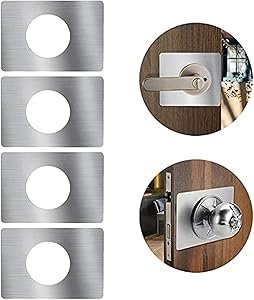
Door hardware isn’t just there for looks; it plays a vital role in keeping your home safe and comfortable. So, how can you ensure your door hardware stays tight and secure over time? Let’s dive into some simple, effective strategies that will help keep everything in top shape.
Regular Inspections: Catch Issues Early
First things first, regular inspections of your door hardware can help you catch problems before they become big headaches. Think of this like going for a check-up at the doctor; you want to nip any issues in the bud. Every few months, take a moment to check each door in your home.
– Look for loose knobs or handles. Are they wiggling more than they should?
– Check hinges for visible wear or rust. If they’re not working smoothly, it’s time for a closer look.
– Pay attention to how easily the door opens and closes. A squeaky or stubborn door is often a sign that something is off.
By keeping an eye on these details, you can address minor issues before they escalate, saving you time and trouble down the line.
Use the Right Tools for Tightening
When it comes to fixing loose door hardware, having the right tools is essential. It’s like trying to bake a cake without the proper ingredients—you might end up with something that’s just not right. Here are a few tools you’ll want on hand:
- Screwdriver: A simple Phillips or flathead screwdriver is usually all you need for tightening screws.
- Hex key: Some door hardware uses hex screws, so having a set of hex keys is beneficial.
- Wrench: If you have door handles that require them, an adjustable wrench can help tighten them up.
Make sure to choose the right tool for each job. Forcing the wrong tool can strip screws or damage the hardware, leading to more problems.
Consider Quality Hardware
Not all door hardware is created equal. Investing in quality materials can make a big difference in longevity. Think about it this way: would you buy shoes made of cheap plastic if you know you’ll wear them every day? Probably not. The same logic applies to door hardware.
Look for brands known for their durability and strength. Solid brass or stainless steel options tend to hold up better than plastic or flimsy metals. They might cost a bit more upfront, but the savings in repairs and replacements over time can be significant.
Additionally, make sure to match your hardware with the right door type. Heavy doors need sturdier hardware, while lighter interior doors can work with more basic options.
Use Thread Locking Adhesives
Here’s a little pro tip: using thread locking adhesives can help keep screws in place over time. It’s like putting glue on a puzzle piece to keep it from moving. Just a small amount of this adhesive on the screws can create a barrier against vibrations and regular use that causes them to loosen.
When applying adhesive, make sure to follow the product instructions carefully. Most adhesives need some time to cure before you can put the door back into action. Once it’s set, you’ll notice less wear and tear on your hardware.
Regular Maintenance: Lubrication and Cleaning
Another important step in preventing door hardware from loosening is regular maintenance through lubrication and cleaning. Think of it like getting an oil change for your car; it keeps things running smoothly.
– Lubrication: Apply a silicone-based lubricant to hinges and moving parts. This reduces friction, ensuring everything operates smoothly and reducing the chances of loosening.
– Cleaning: Dust and debris can build up over time, causing hardware to work harder than it needs to. Use a damp cloth to wipe down knobs, handles, and hinges. Make it a part of your regular cleaning routine for doors.
Taking these steps not only prolongs the life of the hardware but also enhances the overall functionality of your doors.
Check the Door Frame Alignment
Sometimes, loose hardware can be a symptom of a bigger issue: a misaligned door frame. If the door isn’t hanging straight, it can put undue stress on the hardware, leading to fast loosening.
Start by checking the alignment of the door. Is there a gap on one side? Does it stick when you try to open it? If you notice these signs, it might be time to adjust the door frame. You can do this by adjusting the hinges or using shims to align the door correctly.
If this sounds a bit complicated, don’t worry. Lots of online resources can guide you through the process step-by-step, or you can consult a professional for help.
When to Replace Hardware
Despite your best efforts, sometimes it’s just time to replace door hardware. If you’ve tightened it multiple times without success or if you see visible damage like rust or cracks, it might be time to say goodbye. Like an old friend who keeps letting you down, some things are better to move on from.
When replacing hardware, ensure you’re buying quality options that will last. Consider upgrading to something more durable if you previously had a less reliable brand. Remember, investing in good hardware now can save you money and frustration in the future.
In conclusion, keeping your door hardware secure doesn’t have to be a daunting task. With a bit of regular maintenance, the right tools, and a commitment to quality, you can prevent loosening and ensure your doors function properly for years to come. Take these steps seriously, and you’ll find that your doors remain sturdy and reliable, providing the comfort and security your home deserves.